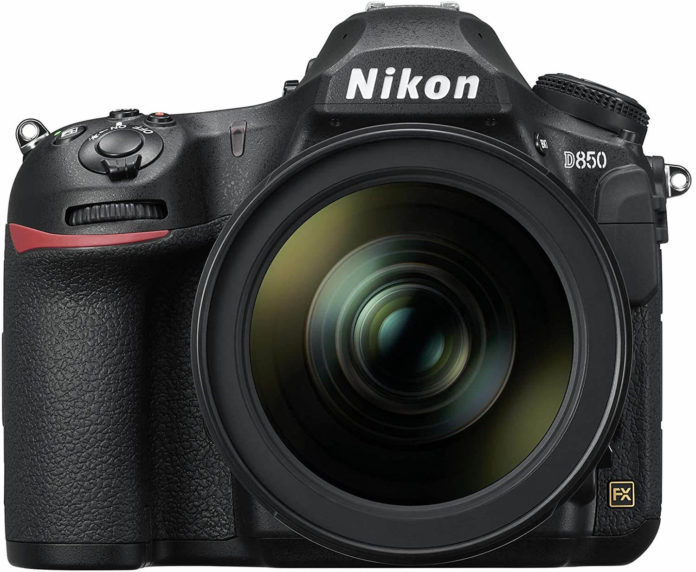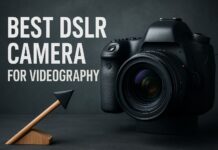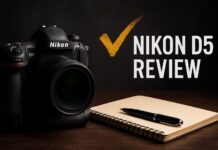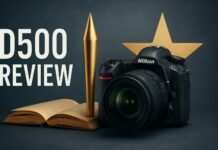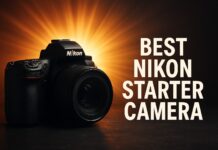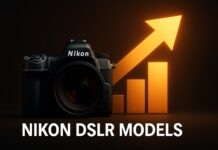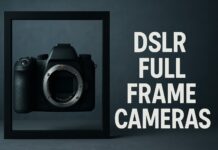The Nikon D850 is the camera that made professionals reconsider mirrorless. Released in 2017, it delivered such exceptional performance that eight years later, photographers still choose it over $6,000 mirrorless flagships. I’ve shot commercial work, weddings, and editorial assignments with this camera alongside newer Z-series bodies. The D850 not only holds its own – in several critical areas, it excels.
This isn’t nostalgia talking. This is an honest assessment from someone who’s spent years comparing the D850 against Nikon’s Z8, Z9, Sony’s A7R V, and Canon’s R5. If you’re considering spending $2,500-3,000 on a camera body, understanding why the D850 remains relevant in 2025 could save you thousands while delivering the image quality your work demands.
Contents
- Why the D850 Matters: Context for 2025
- The 45.7MP Sensor: Where Image Quality Lives
- The 153-Point AF System: Professional Grade
- Shooting Speed: 7-9 fps That Matters
- 4K Video: Full-Frame Without Compromises
- Build Quality: Designed to Last Decades
- Battery Life: The DSLR Advantage
- Lens Compatibility: Decades of Glass
- What the D850 Does Better Than Newer Cameras
- What Mirrorless Does Better
- Who Should Buy the Nikon D850?
- D850 vs Nikon Z8: The Critical Comparison
- Used Market: Where Value Lives
- Real-World Use Cases: When the D850 Excels
- Long-Term Ownership: What to Expect
- Accessories Worth Buying
- Common Questions From Serious Buyers
- Final Assessment: Why the D850 Endures
Why the D850 Matters: Context for 2025
Camera companies need you to believe that last year’s model is obsolete. The D850 destroys this narrative. It represents the pinnacle of DSLR evolution – the refined final answer to decades of engineering. Nikon threw everything into this camera: 45.7MP, 7-9 fps, 4K video, 1,840-shot battery life, and build quality that survives abuse professional cameras shouldn’t.
Then they stopped. The D850 has no true successor. Nikon’s attention shifted entirely to mirrorless Z-series cameras. This makes the D850 unique: it’s the ultimate expression of DSLR technology, frozen in time at peak performance.
The competitive landscape in 2025:
The D850 currently sells for $2,500-2,800 new, $1,800-2,200 used. For comparable resolution and capability, you’re looking at:
- Nikon Z8: $3,600 (superior AF, no battery life advantage)
- Nikon Z9: $5,500 (pro flagship, excessive for most users)
- Sony A7R V: $3,900 (61MP but mirrorless limitations)
- Canon R5: $3,900 (overheating issues, smaller battery)
The D850 delivers 90% of these cameras’ image quality at 60% of the cost. That equation matters when you’re budgeting for glass – the investment that actually determines your images.
The 45.7MP Sensor: Where Image Quality Lives
Megapixels don’t equal quality, but the D850’s sensor is special. This isn’t just high resolution – it’s high resolution with remarkable dynamic range, clean high-ISO performance, and color science that requires minimal correction.
Resolution That Actually Matters
45.7 megapixels means 8256 x 5504 pixel images. Practically, you can:
- Print 40×60 inches at 200 DPI with native resolution
- Crop aggressively – a 50% crop still yields 22MP images
- Deliver commercial work meeting agency technical requirements
- Reframe compositions in post without quality loss
I’ve shot editorial work where art directors request both horizontal and vertical crops from single frames. The D850’s resolution makes this trivial – crop 60% of the image and still deliver magazine-quality files.
The pixel size advantage: Despite high resolution, individual pixels are larger than most mirrorless cameras. This delivers cleaner files with more recoverable shadow detail and better color depth.
Dynamic Range: The D850’s Secret Weapon
The D850’s dynamic range rivals medium format cameras. At base ISO 64, you’re capturing roughly 14.8 stops of usable range. This translates to real-world capability that saves images other cameras can’t.
I’ve shot into direct sun at weddings – backlit ceremonies where the difference between blown highlights and retained detail is this camera’s dynamic range. Lift shadows 4-5 stops in post and they remain clean, detailed, and printable. Try that with most cameras and you get muddy, noisy garbage.
Landscape photographers particularly benefit: High-contrast scenes with deep shadows and bright skies are the D850’s specialty. A single exposure often eliminates the need for HDR or graduated ND filters.
ISO Performance: Better Than Expected
Base ISO 64 delivers maximum dynamic range and color depth. Native range extends to ISO 25,600, expandable to ISO 102,400.
Practical ISO performance:
- ISO 64-400: Absolutely pristine – zero visible noise even at 100% magnification
- ISO 800-1600: Clean enough for large prints with minimal noise reduction
- ISO 3200: Perfectly usable – I shoot weddings at ISO 3200 regularly
- ISO 6400: Acceptable with noise reduction – still printable to 16×20″
- ISO 12,800+: Emergency only – detail degradation becomes significant
The D850 isn’t a low-light specialist like the D750 or Nikon’s Z6 series. However, it performs far better than its 45.7MP resolution suggests. The EXPEED 5 processor handles noise reduction intelligently, preserving detail while controlling grain.
The 153-Point AF System: Professional Grade
Mirrorless cameras dominate autofocus discussions. The D850’s phase-detect AF system still competes effectively for most real-world photography.
AF Coverage and Capability
153 focus points (99 cross-type) cover substantial frame area. The center point focuses down to f/8 – critical for wildlife photographers using teleconverters. The entire system operates down to -4 EV, meaning it locks focus in near darkness.
Where the D850 AF excels:
- Predictable moving subjects (sports, wildlife with consistent motion)
- Manual focus point selection and repositioning
- Group-area AF for erratic subjects
- 3D tracking for subjects moving across the frame
Where mirrorless AF wins:
- Face and eye detection (though the D850 has basic face detection)
- Subject tracking with AI recognition
- AF coverage extending to frame edges
For 90% of professional photography – portraits, weddings, commercial work, landscapes – the D850’s AF system is completely adequate. Wildlife and sports photographers shooting birds in flight or fast, erratic action might prefer mirrorless subject tracking.
The Optical Viewfinder Advantage
Electronic viewfinders have advantages: exposure preview, focus magnification, overlays. However, optical viewfinders offer zero lag, no battery drain, and work perfectly in any lighting.
The D850’s 0.75x magnification viewfinder is Nikon’s largest ever in a non-pro body. Combined with 100% frame coverage, you see exactly what you’re capturing without electronic interpretation. For action photography where split-second timing matters, optical viewfinders still reign.
Shooting Speed: 7-9 fps That Matters
The D850 shoots 7 fps standard, 9 fps with the MB-D18 battery grip. This seems modest compared to mirrorless cameras shooting 20-30 fps.
Reality check: 7-9 fps is plenty for professional work. I’ve shot hundreds of weddings at 5-6 fps. The extra frames help, but they don’t make or break shots. What matters is AF accuracy and timing – both user skills that no frame rate fixes.
Buffer depth is more critical than fps: The D850 handles 51 RAW files or 170 JPEGs before slowing. With fast XQD or CFexpress cards (via adapter), you can shoot continuously without the camera choking. This reliability matters more than maximum burst rate.
4K Video: Full-Frame Without Compromises
The D850 records 4K UHD (3840×2160) at 30p/25p/24p from the full sensor width. This is significant – many cameras crop significantly in 4K, effectively changing lens focal lengths.
Video capabilities:
- Uncropped 4K preserves wide-angle lens perspective
- Clean HDMI output for external recorders
- Zebra stripes and focus peaking aid manual focusing
- Flat picture profile for color grading
- Electronic vibration reduction helps handheld footage
- 8K time-lapse capability (requires additional software)
The limitations: No in-body image stabilization (use VR lenses). Autofocus in video mode is functional but not competitive with mirrorless. The D850 isn’t a dedicated video camera – it’s a stills camera with excellent video capability.
For hybrid shooters needing high-quality B-roll, interviews, or behind-the-scenes content, the D850 delivers. Dedicated cinematographers wanting cutting-edge video AF should look at mirrorless options.
Build Quality: Designed to Last Decades
The D850 uses magnesium alloy construction with comprehensive weather sealing. This isn’t marketing fluff – the camera genuinely withstands professional abuse.
I’ve shot in pouring rain, snow, desert dust storms, and humid tropical environments. The D850 kept working without hesitation. The 200,000-actuation shutter is rated for approximately 10 years of average professional use.
Ergonomics and handling:
The D850 feels substantial without being unwieldy. At 915g (2 lbs), it’s heavier than mirrorless bodies but the weight provides stability for telephoto work. The grip is deep and secure – comfortable for all-day shooting.
The button layout is logical and intuitive for Nikon users. Critical controls (ISO, exposure compensation, AF mode) are accessible without menu diving. The top LCD displays shooting parameters at a glance.
The Tilting Touchscreen
The 3.2-inch tilting touchscreen (2.36 million dots) is genuinely useful. It tilts up for low-angle shots and down for overhead perspectives – covering most practical needs without the complexity of a fully articulating screen that compromises weather sealing.
Touch functionality works well for focus point selection, menu navigation, and image review. Pinch-to-zoom and swipe-to-scroll feel natural. You can also use the touchscreen as a trackpad while looking through the viewfinder – clever implementation.
Battery Life: The DSLR Advantage
1,840 shots per charge with the EN-EL15a battery. This is transformative compared to mirrorless cameras typically delivering 300-500 shots.
Real-world impact:
I shoot entire 10-hour wedding days on two batteries. Compare this to mirrorless shooters carrying 5-6 batteries and constantly managing charge levels. The psychological freedom of not worrying about battery life is underrated.
Cold weather performance is excellent – DSLRs don’t suffer the dramatic battery drain mirrorless cameras experience in freezing temperatures.
Lens Compatibility: Decades of Glass
The D850 mounts Nikon F-mount lenses – a system spanning 60+ years. This includes:
- Modern Nikkor AF-S lenses with VR
- Classic manual focus Nikkors (with metering)
- Third-party options from Sigma, Tamron, Tokina
- Specialized lenses no longer produced
The used F-mount market is massive. You can find professional-grade glass at 40-60% off retail. The D850’s high resolution demands quality optics, but excellent lenses are affordable used.
See our recommended lenses for the D850 for specific glass worth pairing with this body.
Lens selection strategy: The D850 rewards sharp lenses. Use professional-grade optics – the 24-70mm f/2.8E, 70-200mm f/2.8E, or high-quality primes. Consumer zooms won’t fully exploit the sensor’s resolution.
What the D850 Does Better Than Newer Cameras
Battery Life: 1,840 shots crushes any mirrorless camera. This isn’t incremental – it’s a fundamental advantage for event, wedding, and travel photography.
Optical Viewfinder: Zero lag, no battery drain, works perfectly in bright sunlight. For action photography, the optical viewfinder’s lack of processing delay remains advantageous.
Build Durability: The proven track record of D850 bodies lasting 5-7 years of professional use. Mirrorless cameras haven’t been around long enough to establish similar reliability data.
Ergonomics for Big Glass: The substantial body balances well with large telephoto lenses. Mirrorless cameras feel front-heavy with professional glass.
Value Proposition: $1,800-2,200 used for near-flagship performance. Comparable mirrorless cameras cost $3,600-5,500. The $1,500-3,000 savings buys exceptional glass.
What Mirrorless Does Better
Honesty requires acknowledging where the D850 trails newer technology:
Autofocus: Mirrorless eye-AF and subject detection are more sophisticated. For portrait photographers shooting wide-open with ultra-fast lenses, mirrorless AF provides an edge.
Video AF: The D850’s video autofocus is functional but dated. Mirrorless cameras track subjects smoothly during video recording.
Silent Shooting: The D850’s silent mode dampens but doesn’t eliminate shutter noise. Mirrorless electronic shutters are completely silent.
Size/Weight: Mirrorless bodies are smaller and lighter. This matters for travel photographers or anyone carrying gear long distances.
Future-Proofing: Nikon’s development focuses on Z-mount. New lenses, features, and technology prioritize mirrorless.
Who Should Buy the Nikon D850?
Perfect for:
- Landscape photographers demanding maximum resolution and dynamic range
- Commercial photographers needing large, detailed files for print
- Wedding photographers wanting bulletproof reliability and battery life
- Studio photographers where AF sophistication isn’t critical
- Professionals with extensive F-mount lens collections
- Photographers prioritizing image quality over cutting-edge AF
- Anyone wanting flagship performance at mid-range pricing
Consider alternatives if you:
- Shoot primarily birds in flight or extremely erratic wildlife (Z8/Z9 AF better)
- Need cutting-edge video with advanced AF tracking
- Prioritize minimal size and weight above all else
- Must have the latest technology regardless of cost
- Shoot portraits wide open with ultra-fast glass where eye-AF helps significantly
D850 vs Nikon Z8: The Critical Comparison
The Z8 is Nikon’s modern equivalent – 45.7MP, professional build, advanced AF. It costs $3,600.
Z8 advantages:
- Superior autofocus with subject detection
- 8K video capability
- In-body image stabilization
- Silent electronic shutter
- Smaller, lighter body
D850 advantages:
- $1,000-1,800 less expensive
- Optical viewfinder
- 3x better battery life
- Compatible with 60+ years of F-mount glass without adapters
- Proven 8-year track record
The decision: If you shoot fast-moving subjects where advanced AF matters significantly, the Z8’s $1,000 premium may be justified. For landscape, commercial, wedding, and studio work, the D850 delivers essentially identical image quality at substantially lower cost.
Used Market: Where Value Lives
The D850 used market is mature. Bodies with 20,000-50,000 actuations (10-25% of shutter life) sell for $1,800-2,000. This is exceptional value – you’re getting a camera with 150,000+ actuations remaining.
What to check when buying used:
- Shutter count (request report from seller)
- Sensor condition (check for dust, scratches)
- Weather sealing integrity (inspect port covers)
- LCD condition (minor scratches acceptable, deep gouges problematic)
- Button functionality (test all controls)
- Included accessories (battery, charger, strap, manual)
Where to buy used: KEH Camera, MPB, B&H Photo used department, Fred Miranda forums (photographer-to-photographer sales). Avoid eBay unless the seller has extensive positive feedback for camera equipment.
Warranty consideration: Used cameras typically carry no warranty. However, the D850’s proven reliability and mature design mean failure rates are low. I’d rather buy a $2,000 used D850 than a $3,000 refurbished mirrorless with 90-day coverage.
Real-World Use Cases: When the D850 Excels
Landscape Photography
The D850 is arguably the best landscape camera ever made. The combination of 45.7MP resolution, exceptional dynamic range, and base ISO 64 captures the detail and tonal range landscape work demands.
I’ve printed D850 landscapes at 40×60 inches for gallery exhibitions. The files hold up perfectly – sharp corner to corner with quality lenses, rich color depth, and recoverable shadow detail that saves high-contrast scenes.
Commercial and Product Photography
The D850 meets technical requirements for commercial stock agencies and advertising work. The resolution allows significant cropping freedom, the color accuracy requires minimal correction, and the file quality passes client scrutiny at any size.
Focus stacking mode (often overlooked) is genuinely useful for product photography. The camera automatically shifts focus across multiple shots, which you blend in post for impossible depth of field.
Wedding and Event Photography
Reliability matters more than cutting-edge features for wedding work. The D850 has never failed me. The battery life eliminates mid-event recharging. The weather sealing handles outdoor ceremonies in questionable conditions. The image quality delivers files that print beautifully in wedding albums.
The 51-point buffer means I can shoot first dances, cake cutting, and bouquet tosses without the camera choking. Dual card slots (one XQD, one SD) provide backup security – critical when photos can’t be reshot.
Wildlife Photography (Non-Birds)
For predictably-moving wildlife – mammals on game drives, animals in zoos, marine life – the D850’s AF system is completely adequate. The APS-C crop mode provides a 1.5x reach multiplier (19.4MP images), extending telephoto lenses effectively.
Where the D850 struggles: birds in flight with erratic movement patterns. The Z8/Z9’s subject detection AF is genuinely superior here. However, for most wildlife photography, the D850 performs excellently with proper technique.
Long-Term Ownership: What to Expect
The D850 is built for longevity. Expect 10+ years of reliable service with proper care.
Common wear items:
- Shutter mechanism (200,000 actuations, then $400 replacement)
- Battery (loses capacity after 3-5 years, $60 replacement)
- Rubber grips (can peel after heavy use, cosmetic only)
Maintenance recommendations:
- Professional sensor cleaning annually ($75)
- Firmware updates from Nikon (free, improves performance)
- Keep firmware current – Nikon released updates improving AF performance
- Use quality memory cards (SanDisk Extreme Pro, Lexar Professional)
Service and support: Nikon still fully supports the D850 with parts availability and repair services. This camera isn’t being abandoned despite mirrorless focus.
Accessories Worth Buying
MB-D18 Battery Grip ($400): Adds 9 fps shooting, better balance with telephoto lenses, and dual battery capacity. Essential for professional sports/wildlife work.
Spare EN-EL15a Batteries ($60 each): Despite excellent battery life, carrying one spare is smart. Buy genuine Nikon – third-party batteries fail unpredictably.
XQD Memory Cards: The D850’s XQD slot is faster than SD. Sony XQD G-series (440MB/s) or CFexpress (via FTZ adapter) maximize buffer performance.
Screen Protector: The touchscreen is durable but a glass protector prevents scratches ($15 investment protecting $2,500 camera).
Really Right Stuff L-Bracket ($180): For serious landscape/commercial work, an L-bracket enables quick portrait/landscape orientation on tripods without repositioning.
Common Questions From Serious Buyers
Is the D850 still worth buying in 2025?
Absolutely. The D850’s capabilities haven’t diminished. Image quality remains exceptional. The camera still outperforms many current models costing significantly more. The used market makes it incredible value.
Should I buy D850 or wait for a successor?
There likely won’t be a direct D850 successor. Nikon’s development is focused on mirrorless Z-series. The D850 represents the final evolution of their DSLR line.
How does the D850 compare to medium format?
The D850 delivers 80-85% of entry-level medium format (Fuji GFX 50S II, Hasselblad X1D) image quality at half the cost. For most work, the difference isn’t visible. Medium format’s advantages – larger sensor, better color depth – matter primarily for high-end commercial work requiring ultimate quality.
Can the D850 use Z-mount lenses?
Only with the FTZ adapter ($250). However, this defeats the purpose – you’re adding weight, complexity, and cost to use lenses designed for a different system. The D850 works best with F-mount glass.
What shutter count is too high for a used D850?
Under 100,000 actuations is ideal. 100,000-150,000 is acceptable with price adjustment. Above 150,000, factor in potential shutter replacement costs ($400-500). The 200,000 rating is conservative – many D850s exceed this significantly.
Is the D850 good for astrophotography?
Yes, excellent. The dynamic range, high resolution, and good high-ISO performance make it popular with astrophotographers. The long exposure noise reduction works well. However, dedicated astrophotography cameras (modified for H-alpha) have advantages for deep-sky imaging.
Final Assessment: Why the D850 Endures
The photography industry sells urgency – buy the latest or fall behind. The D850 proves this narrative false.
This camera represents the culmination of decades of DSLR evolution. Every element – sensor performance, AF reliability, build quality, ergonomics – reflects mature engineering solving real photographic challenges. Nothing about the D850 feels experimental or compromised.
Eight years after release, it remains relevant because fundamental photographic requirements haven’t changed. Photographers still need resolution for detailed prints. Dynamic range for high-contrast scenes. Build quality for reliability. Battery life for all-day shoots. The D850 delivers these fundamentals at a price point that makes economic sense.
Mirrorless cameras offer genuine advantages – better AF for specific subjects, advanced video features, smaller size. However, these advantages come at significant cost premiums while introducing limitations (battery life, lens availability, long-term reliability data).
For photographers prioritizing image quality, reliability, and value – the professionals who earn income from their work and serious enthusiasts who understand what actually matters – the Nikon D850 remains one of the smartest investments in photography.
Buy it. Pair it with exceptional glass. Focus on making photographs instead of chasing specifications. The D850 will serve you brilliantly for the next decade.


